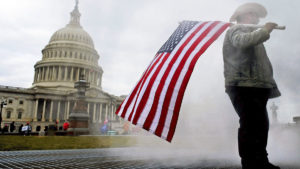It’s unclear how far Elon Musk’s pledge to restore free speech to Twitter will go; it wasn’t long ago that you could easily stumble upon entire ecosystems of online jihadis and their fanboys on the site. As one surrealist Twitter account put it: “i miss ISIS twitter. when u could just get on here and click around for a bit and find some guys in ISIS on here tweeting about it, posting their cool ass trucks and shit”.
Back before Big Tech cracked the whip on jihadis and their online fanboys, it wasn’t uncommon for journalists and analysts to interact directly with terrorists in distant war zones, even building something of a rapport. The bizarre tension of these interactions, between battle-hardened religious fanatics and those on the other side of their celestial war, was not lost on terrorism scholar J.M. Berger. Describing his virtual relationship with an American al-Shabaab fighter, he noted how it became “part of my daily routine… to check in with a terrorist with a professed love of al-Qaida in Somalia on the other side of the world.”
Jihadist groups recognised the enormous and unprecedented potential reach that social media afforded. Posts by Isis fighters formed part of a deliberate grassroots strategy to flood the internet with unofficial propaganda to complement the organisation’s glossier official output.
Initially, Western security services were indulgent toward the tweeting terrorists, thanks largely to the treasure trove of intel they provided. Jihadist recruits would post photographs with easily geolocatable features — treelines, ridges, hills and apartment buildings — and pose for selfies that would haunt them in court many months or years later. Posts also provided valuable insights into internal dynamics and even instability within terrorist groups. The American in al-Shabaab live-tweeted his dispute with the organisation’s mainly Somali leadership, a dispute which ended in his eventual assassination. Leaving jihadis online, it was argued, left them right where we could see them.
The summer of 2014 changed all that.
In June that year, Isis easily overran Mosul — and the US trained and equipped Iraqi forces defending it — and declared a caliphate. This declaration transformed the trickle of foreign fighters joining the group (now a quasi-state) into a flood. In the weeks that followed, “Isis Twitter” was drunk on battlefield triumphalism, apocalypticism and a catalogue of pornographic violence — violence that was “instantly accessible at the click of a mouse.”
Despite a litany of other atrocities, it was the filmed execution of American reporter James Foley in August that prompted decisive action. Here was an act so monstrous, and with such reach, that social media companies changed their content moderation policies almost overnight. “We have been and are actively suspending accounts as we discover them related to this graphic imagery. Thank you”, tweeted Twitter CEO Dick Costolo the morning after a video of the beheading was posted online. Facebook took similar action, mere months after defending its decision to leave videos of cartel atrocities online.
Jihadis had beheaded victims on camera before, but never in such high definition and never at the hands of a masked executioner with an unmistakable British accent. (The killer, nicknamed “Jihadi John” by the press, was later revealed to be a London-raised IT salesman named Mohammed Emwazi.) Perhaps the accent was the decisive element which prompted such a response: instead of violence between distant and unfamiliar people, the killer was one of our own. And, unlike the terrorist spectacle of 9/11, the sickening act of decapitating helpless captives represented what the philosopher Adriana Cavarero has described as horrorism: “An ontological crime well beyond the inflicting of death.”
Revisiting the commentary in the days that followed is like peering through a window to another planet. The New Yorker asked “Should Twitter Have Taken Down the James Foley Video?”, while Slate ran the headline: “Did Twitter and YouTube Make the Right Call in Suppressing Images of James Foley’s Beheading?” Both explored the possible consequences of the companies adopting editorial control.
At the same time, Western governments were leaning heavily into the narrative that the exodus of their own citizens to the newly declared caliphate was a product of gruesome Isis propaganda. Tech companies sought to deflect mounting pressure from governments over terrorist content, but they could not outright reject the charge that their platforms were influencing minds and behaviour — it is central to their ad-based business model.
Government concern over online radicalisation and the loose changed tech companies deigned to throw at initiatives countering it fostered the emergence of an online extremism industry. Despite its efforts, a considerable radicalisation has since taken place — a radicalisation not of large numbers of internet users transformed into terrorists by social media, but of the entire discourse on online terrorism and the field it sustained.
The response to Jihadi John’s campaign of choreographed butchery set the precedent that tech companies could be pressured and shamed into censoring extremist content. Since then, the number of people and groups who’ve come under the microscope of online extremism entrepreneurs has dramatically expanded, as has the list of ideologies deemed near-terroristic.
Sexless men on the internet are the next great terror threat. Criticising immigration policy is mainstreaming the Great Replacement conspiracy theory. Gender critical feminists are peddling hate. Millions of Americans are in fact, “mass radicalised”. Free speech itself is a far-Right talking point. Critics of Covid lockdowns were spreading misinformation and making bedfellows of the far-Right. As terrorism scholar Simon Cottee put it, “Nobody in this game, if we’re honest, has an interest in seeing radicalisation go away. It’s bad for business. We need radicalised people, and if we can’t find them, we’ll invent them.”
It used to be that “radicalisation” meant the process that led individuals to kill for politics. But, responsive to the latest controversies and funding incentives of the day, it has expanded to cover broader concepts such as “hate”, “mis/disinformation”, “harm” and more, dangerously blurring the lines between political debate and counter-terrorism. This confusion was helped along by the narrative of resurgent fascism that accompanied the populist victories of 2016. In some counter-extremism circles, Brexit and Trump could be mentioned in the same breath as the present-day genocidaires of Isis.
If this list of new extremists and terrorists sounds like a list of progressive bogeymen, it is. The constellation of extremism NGOs and academic centres fill their rosters from social classes where certain interests, prejudices and worldviews are near hegemonic. Those interests happen to strongly overlap with the incumbent governments in both Canada and the United States, who are of course content for likeminded organisations to define who is an extremist and who is an upstanding citizen deserving of an online presence.
This political alignment grants access to funding opportunities, as well as platforms in a sympathetic media environment, for progressive extremism experts, who can in turn paint targets for politically sympathetic moderators in Silicon Valley and pressure them to act.
The threat to free speech and civil liberties posed by this arrangement should be obvious to all but the most partisan. This is not just a cheap pop at progressivism. It should barely need saying that the danger would be just as real if the industries at hand were dominated by conservatives and if conservatives ruled the roost in Ottawa and D.C. But at present, they aren’t and don’t.
Nor is it enough to point out that the Big Tech companies are private. As free speech guru Jacob Mchangama has observed of the major social media platforms: “No government in history has ever been able to exert such extensive control over what is being said, read, and shared by so many people across the world and in real time.” These platforms are the public square now; upstart competitors are liable to be crushed, sometimes under political and media pressure amid accusations of extremism.
It seems unlikely Elon Musk will be reinstating Isis Twitter on free speech grounds. But today, the legitimate debate on how far platforms should go in response to online extremism is less likely to focus on Jihadi John’s beheading videos than on Joe Rogan’s podcast or a contrarian Substack. The historian of populism Thomas Frank summed up the dominant attitude among his fellow liberals: “The remedy for bad speech, we now believe, is not more speech, as per Justice Brandeis’s famous formula, but an ‘extremism expert’ shushing the world.”
As the recent jihadist assassination of David Amess MP shows, even with actual attacks, our culture seems unable to process terrorism through any lens other than an immediate clamour for greater online controls and censorship. Eight years after Isis splattered blood and gore across social media, we still need real expertise and study of extremist and terrorist groups. What we do not need is an industry laundering censorious agendas as impartial expertise, enforcing partisan truths to combat disinformation, or managing public debate under the guise of counter-terrorism.
Disclaimer
Some of the posts we share are controversial and we do not necessarily agree with them in the whole extend. Sometimes we agree with the content or part of it but we do not agree with the narration or language. Nevertheless we find them somehow interesting, valuable and/or informative or we share them, because we strongly believe in freedom of speech, free press and journalism. We strongly encourage you to have a critical approach to all the content, do your own research and analysis to build your own opinion.
We would be glad to have your feedback.
Source: UnHerd Read the original article here: https://unherd.com





